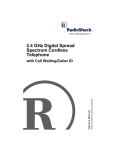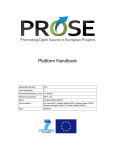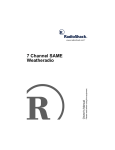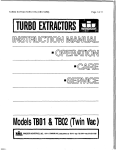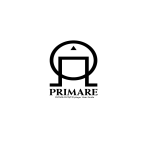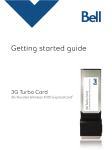Download Radio Shack Digital Telephone Answering Device Owner`s manual
Transcript
2TQHGUUKQPCN"*KIJ"%CRCEKV["&KIKVCN"#PUYGTKPI"5[UVGO 43-3803 %106'065 Answering System Features ............................... 1 Caller ID Features ............................................... 2 Installation ........................................................... 2 Connecting the System ....................................... 2 Installing a Backup Battery .................................. 2 Answering System ............................................... 2 Preparation .......................................................... 2 Turning the System On/Off ............................... 2 Setting Up Your System ................................... 2 Setting the Number of Rings ............................ 3 Using Toll Saver ............................................... 3 System Operation ................................................ 3 Recording the Outgoing Messages ..................... 3 General OGM ................................................... 3 Announce Only OGM ....................................... 3 Setting the VIP Number ................................... 3 Reviewing VIP Numbers .................................. 3 Recording VIP OGM ........................................ 3 VIP Alert Tone .................................................. 3 Setting the System to Answer Calls .................... 4 Using the Announce-Only Feature ................... 4 Memo Recording .............................................. 4 Two Way Recording ......................................... 4 Using Silence ................................................... 4 Screening Calls ................................................ 4 Playing Incoming Messages/ Memos/ 2-Way Conversations ............................................................ 4 Playing VIP Messages ..................................... 5 Deleting Voice Messages .................................... 5 Remote Operation ............................................... 5 Remote Operation Security Code .................... 5 Operating the Answering System from a Remote Location ............................................................ 5 Remote Commands ......................................... 5 Caller ID Operation .............................................. 5 Reviewing Caller ID Records .............................. 6 Using the Master/Secondary Switch ................... 6 Call Back from the Caller ID Memory .................. 6 Receiving Call Waiting Calls ................................ 6 Caller ID Messages ............................................. 6 Deleting Caller ID Records .................................. 7 Troubleshooting ................................................... 7 Care 7 Important Caller ID Information To use this Caller ID, you must be in an area where Caller ID service is available, and you must subscribe to the service. Where Caller ID is offered, one or more of the following options are generally available: • caller’s number only • caller’s name only • caller’s name and number OWNER’S MANUAL — Please read before using this equipment. For the system’s Caller ID memory dial feature to operate, you must receive the caller’s number. READ THIS BEFORE INSTALLATION We have designed your system to conform to federal regulations and you can connect it to most phone lines. However, each device that you connect to the telephone line draws power from the line. We refer to this power draw as the system’s ringer equivalence number, or REN. The REN is shown on the bottom of your system. If you use more than one system or other device on the line, add up all the RENs. If the total is more than five (three in rural areas), your telephone might not ring. If ringer operation is impaired, remove one of the devices from the line. FCC STATEMENT Your system complies with Part 68 of FCC Rules. You must, upon request, provide the FCC registration number and REN to your telephone company. These numbers are on the bottom of the system. You must not connect your system to: • coin-operated systems • party-line systems • most electronic key phone systems THE FCC WANTS YOU TO KNOW In the unlikely event that your system causes problems on the telephone line, the telephone company can disconnect your service. The telephone company normally attempts to notify you in advance. If advance notice is not practical, the telephone company notifies you as soon as possible and advises you of your right to file a complaint with the FCC. Also, the telephone company can make changes to its lines, equipment, operations, or procedures that could affect the operation of this telephone. The telephone company notifies you of these changes in advance so you can take the necessary steps to prevent interruption of your telephone service. LIGHTNING Your system has built-in protection circuits to reduce the risk of damage from surges in telephone line current. These protection circuits meet or exceed the FCC requirements. However, lightning striking the telephone lines can damage your telephone and the system. Lightning damage is not common. Nevertheless, if you live in an area that has severe electrical storms, we suggest that you unplug your telephone and the system when storms approach to reduce the possibility of damage. Your RadioShack Digital Telephone Answering System with 99/99 CID Memory is a combination high-quality fully-digital answering system and Caller ID. The system prevents you from missing incoming calls and messages. Fully digital means the system stores all messages on a computer chip. This gives you capabilities that tape-based answering machine do not have. There is no tape mechanism to wear out and no tapes to bother with. Also, you can listen quickly from message to message without listening to all of them. The system displays the caller’s telephone number (and name, if available in your area) and the current date and time, as provided by your local phone company to Caller ID service subscribers. It saves up to 99 Caller ID records that you can review and call back. ANSWERING SYSTEM FEATURES Twelve Outgoing Messages — lets you record twelve outgoing messages of up to about 30 seconds each: eleven for when you want callers to leave a message (ten VIP callers and a non-VIP caller), one for when you want to play an announcement without recording callers’ messages. Voice Date/Time Stamp — records the day and time each message was recorded. Two-Way Recording — lets you record both sides of your phone conversation. Memo Recording — lets you leave messages for yourself or others. © 2002 RadioShack Corporation. All Rights Reserved. RadioShack and RadioShack.com are trademarks used by RadioShack Corporation. Adjustable Ring Number — lets you set the system to answer after two, four, or seven rings. Callback — lets you dial the phone number in a Caller ID record with the touch of a button. Toll-Saver — lets you avoid unnecessary toll charges when you call by long-distance to check your messages. Call Waiting ID — displays information about an incoming call when you are on the phone. Remote Operation — lets you use a touchtone phone (or rotary phone and pocket tone dialer) to operate the system and Caller ID while you are away from your home or office. +056#..#6+10 Phone Pick-Up Detection — stops recording when you pick up any phone on the same line as the system. Call Screen — lets you listen as a caller leaves a message so you can decide whether or not to answer the call. Programmable Remote Operation Security Code — lets you set your own security code for remote operation. High Memory Capacity — lets you record up to 25 minutes of messages, memos and two-way phone conversation. Ten VIP Memory with Mailbox and Alert Tone — lets you save up to ten caller ID records in the VIP list and record a VIP caller’s message in each VIP mailbox. Then, when a VIP caller calls, the system sounds a distinctive tone. Mailbox with Individual OGM — lets you record a personalized outgoing announcement for each VIP mailbox. When a VIP caller calls, the system plays your announcement and records the caller’s message in its own VIP mailbox. Mailbox with Audible and Visual Alert Indicator — alerts you to a new message in a VIP mailbox with an audible tone and individual lighted indicator. CALLER ID FEATURES 3-Line Display with Backlight — lets you view an entire Caller ID record on one screen. Caller ID Memory — stores up to 99 Caller ID records with name and number or name only, depending on the information your phone company provides. Multi-Language — displays caller ID messages in English or Spanish. New Call Indicator — lets you see at a glance that you have new calls. Review Scrolling — lets you easily scroll through all records in Caller ID memory. 2 Select a location for the system that is near a modular telephone line jack, a telephone, and an AC outlet, and is not in the way of normal activities. CONNECTING THE SYSTEM Your telephone connects directly to a modular telephone line jack. If your telephone wiring does not have a modular jack, you can update the wiring yourself using jacks and adapters (available at your local RadioShack store), or have the telephone company update the wiring for you. You must use compatible modular jacks that are compliant with Part 68 of FCC Rules. Note: The USOC number of the jack to be installed is RJ11C. Follow these steps to connect your system to the telephone line and phone. 1. Unplug the telephone’s modular cord from the modular phone line jack and plug it into the PHONE jack on the back of the system. 2. Plug one end of the supplied modular cord into the LINE jack on the back of the system and plug the cord’s other end into a modular phone line jack. Cautions: You must use a Class 2 power source that supplies 9V DC and delivers at least 500 mA. Its center tip must be set to positive and its plug must fit the system's DC 9V 500 mA jack. The supplied adapter meets these specifications. Using an adapter that does not meet these specifications could damage the system or the adapter. ! • Always connect the AC adapter to the system before you connect it to AC power. When you finish, disconnect the adapter from AC power before you disconnect it from the system. 3. Insert the supplied AC adapter’s barrel plug into the DC 9V 500 mA jack on the back of the system. Plug the other end of the adapter into a standard AC outlet. Note: This system cannot operate without AC power. INSTALLING A BACKUP BATTERY If the AC power fails or you unplug the system, you need one 9V alkaline backup battery (not supplied) to save the answering system’s messages and settings for the day and time. For the best performance and longest life, we recommend you use a RadioShack alkaline battery. Caution: Use only fresh batteries of the required size and recommended type. 1. Use a flat-blade screwdriver to lift up and remove the battery compartment’s cover. 2. Attach a 9V alkaline battery to the terminals and place the battery in the compartment. 3. Snap the battery compartment cover into place. Replace the battery when appears. Warning: Dispose of the old battery promptly and properly. Do not burn or bury it. Cautions: • Before you replace the battery, be sure the system is properly connected to AC power. Otherwise, you might lose any stored information. • Disconnect the telephone line cord before replacing the battery to reduce the risk of fire or injury. Use only a 9V alkaline battery. • If you do not plan to use the system with batteries for a month, remove the battery. A battery can leak chemicals that can destroy electronic parts. #059'4+0)"5;56'/ PREPARATION When you first connect power, ?d_j_Wb_pWj_ed and '(0&&ý 7C and '%&' appears. The system runs a self test, and sets all internal default values followed by 4 tones. I[b[Yjý BWd]kW][, 7h[Wý9eZ[, F?D, :Wo E< M[[a appear, then the system beeps twice and &ý D[mý &ý JejWbý appears. To set your own language, area code pin and day of the week, see “Setting Up Your System.” Turning the System On/Off To turn on the system, press ANSWER ON/ OFF. The ANSWER ON/OFF indicator lights and the system beeps once. The system is set to answer calls. Setting Up Your System After you turn on the system, press TIME SET/ SKIP. I[b[Yjý BWd]kW][ appears and then ;D= ;IF. Follow these steps to set up your system 1. Press 9VOLUME8. ;D= or ;IF flashes to indicate which language you selected. After you select the language, press REVIEW 7#to confirm the language. 2. After you select the language, 7H;7 F?D :7OUMAý appears. Press 9VOLUME8 to select the area code and press REVIEW7 to move the cursor to the next digit. After you select the area code, press REVIEW7# to confirm the area code. 3. Press 9VOLUME8# to select the PIN code (3 digit remote operation security code) and press 6REVIEW7 to move the cursor. After you select the pin code, press REVIEW7 to confirm the pin. Note: The preset pin code is 000. is at :7OUMA. Press 9VOLUME8 to enter the day of the week. Press REVIEW7 to confirm the day of the week. 4. The cursor 5. Press 9VOLUME8 to select the hour, then press REVIEW 7 to confirm the hour. 6. Press 9VOLUME8 to select the minute, then press REVIEW7 to confirm the minute. 7. Press 9VOLUME8 to select the month, then press REVIEW7 to confirm the month. 8. Press 9VOLUME8 to select the date, then press REVIEW 7 to confirm the date. Notes: • Press 6REVIEW7 to move the cursor when setting the date and time. • The month, day and time can be updated by the first incoming call with Caller ID information. • After the day and time are set, they are updated by the first incoming call, the system announces the time and day when you press TIME CHECK/REPEAT. • To change the above settings, press TIME SET/SKIP to repeat Steps 1 through 8. Press STOP to end setting actions. To avoid losing the day and time settings if AC power fails, we recommend you install a backup battery before you set the day and time (see “Installing a Backup Battery” on Page 2). Setting the Number of Rings Set 2/4/7/TS located on the right side of the system to 2, 4, 7 to set how long the system waits before it answers a call (2 rings, 4 rings, 7 rings). Using Toll Saver To help you avoid unnecessary long distance charges, you can set 2/4/7/TS to TS (Toll Saver). Once you select TS, if there are new messages, the system answers on the second ring. If there are no new messages, the system answers on the fourth ring. This feature gives you time to hang up after the third ring when you are checking messages from a long-distance location. 5;56'/"12'4#6+10 RECORDING THE OUTGOING MESSAGES General OGM The system has a prerecorded outgoing message that says “Hello, please leave a message after the tone.” Use this message or record your own. 1. Press ANNOUNCE and Fbiý I[b[Yjý E=C appears. 2. Hold down PLAY, speak into the microphone. Release the button when you finish your message. The system automatically plays back your recorded message. Notes: • The maximum length for an outgoing message is 30 seconds. When it reaches the maximum outgoing message length, the system sounds a tone. • If you record your own message and subsequently decide to use the prerecorded message, press ANNOUNCE and then press PLAY to play the general OGM, then press DELETE during playback to erase the recorded message. stop listening to the outgoing message before it ends, press STOP. • If you have recorded your OGM, PLAY flashes when you press ANNOUNCE. Announce Only OGM 1. Press ANNOUNCE and Fbiý I[b[Yjý E=C appears. 2. Hold down ANNOUNCE, speak into the microphone. Release the button when you finish your message. The system automatically plays back your recorded message. Note: • The maximum length for an outgoing message is 30 seconds. • To hear the announce-only OGM at any time, press ANNOUNCE twice. To stop listening to the outgoing message before it ends, press STOP. • If you have not recorded an announceonly OGM and the switch is set to ANNC ONLY, the system answers telephone line after 2 rings and plays a prerecorded announce-only OGM that says “No one is available to take your call,” then sounds 5 beeps. Enter the remote operation security code within 10 seconds, then enter 8# to start recording your announce-only OGM. To stop recording, enter 5#. Your OGM automatically plays back once. • The announce-only OGM does not affect your original OGM that tells callers to leave a message. Each OGM can be recorded, played back, or deleted independently. Setting the VIP Number Your system automatically saves an incoming VIP message into a specified location. You can review these VIP caller’s message by pressing the VIP button. After you set a phone number as a VIP number, and the incoming call matches the VIP number, the system stores the voice message into the specified VIP mailbox. To set the VIP number: 1. Press 6 REVIEW 7 until the desired Caller ID memory location displays. 2. Press VIP, then press VIP Mailbox 1–10 for the desired VIP location. The VIP mailbox flashes to indicate you have stored a phone number. • To hear the general OGM at any time, press ANNOUNCE and then PLAY. To 3 Reviewing VIP Numbers To review the VIP number you specified, make sure the system is set to answer calls. Press VIP, then press 6REVIEW7 to review the VIP mailbox numbers one by one. If no VIP is set in the mailbox, L?FýNNýdejýI[j appears. You can delete the number stored in the VIP mailbox. When reviewing the VIP number, press DELETE. Recording VIP OGM The system has ten VIP mailboxes. You can record a 30-second individual message in each VIP box. 1. Press ANNOUNCE and Fbiý I[b[Yjý E=C appears. 2. Hold down the VIP 1–10 and speak clearly into the microphone. Release VIP 1–10 when you finish your message. The system automatically plays back your recorded message. Note: After you finish recording and press ANNOUNCE, If an VIP mailbox has a VIP OGM recorded, its indicator flashes. VIP Alert Tone The system lets you store up to ten phone numbers in its VIP call list. Whenever someone calls from one of those ten numbers, if you subscribe to Caller ID, the system will sound an alert tone (single beep) in between incoming phone rings to indicate that a VIP call is coming in. This alert tone continues until the call is answered. The system sounds an alert tone (double beep) every 15 seconds to remind the user that some VIP messages in VIP mailboxes have not been reviewed. To disable the VIP alert feature of incoming call and new message, hold down VIP for 3 seconds and the display shows the current setting of VIP alert. If L?Fý7B;HJ ED appears, press 6REVIEW7 to change to L?Fý 7B;HJ E<<. Press STOP to exit. The system automatically exits after 15 seconds without any key being pressed. SETTING THE SYSTEM TO ANSWER CALLS Set 1/5/ANNC ONLY to 1 or 5 to select 1 minute or 5 minutes as the maximum length of incoming messages. To set the system to answer calls, press ANSWER ON/OFF. The ANSWER ON/OFF indicator turns on. To set the system so it does not answer calls, press ANSWER ON/OFF so the ANSWER ON/ OFF indicator turns off. 4 When there is an incoming call, 9Wbb[hý?: appears when the system is on. The outgoing message plays after the system answers, then the system beeps and begins recording. The caller can leave a message of up to 1 or 5 minutes in length, depending on the setting of 1/5/ANNC ONLY. After the call (when the caller hangs up, or there is silence for more than seven seconds, or the recording maximum message length), the system hangs up and resets to answer the next call. The New Call indicator flashes to indicate the system recorded a new incoming message. Notes: Note: Follow these steps to record a memo up to 1 minute. • The system supports a maximum of 92 incoming messages and outgoing messages. • If the system’s memory reaches its maximum capacity while a caller is leaving a message, the system stops recording, beeps and then hangs up. If the system receives a call when its memory is full, it answers after ten rings and plays “No one is available to take your call”, waits for any remote operation commands, then hangs up. The system cannot record additional messages until you delete at least some of the old ones (See “Deleting Voice Messages” on Page 5). • If you want to record an OGM, memo or two-way phone conversation when its memory is full, the system announces “Memory is full”. • Many local phone companies use calling party control (CPC) to signal that the caller has hung up. Your system can recognize a CPC signal and release the line. If the system records phone company messages or dial tones, your local phone company probably does not use CPC. Using the Announce-Only Feature Your system’s announce-only feature lets you play a message for the caller then automatically hang up without letting the caller leave a message. To select announce-only, set 1/5/ANNC ONLY to ANNC ONLY. When the system receives a call, it plays the announce-only message and displays the Caller ID. After the announcement, the system sounds 5 beeps, and stays on line for 10 seconds so you can enter the remote operation security if necessary. If the system receives no code within ten seconds, the system hangs up and resets to answer the next call. To turn off announceonly, set 1/5/ANNC ONLY to either 1 or 5. • When the system is set for announceonly, you cannot set it to record calls using the remote commands. • You can still use remote commands to perform all operations. • The system always answers on the second ring except when the memory is full. Memo Recording 1. Hold down 2 WAY/MEMO. After the beep, speak clearly into the microphone from about ten inches in front of the system. 2. Release 2 WAY/MEMO when you finish your message. Two Way Recording Important: Every state has different regulations governing the recording of conversations over the telephone. Be sure to check your local, state and federal laws before using this product to record any telephone conversation in order to determine that your use is in compliance with such laws or guidelines. You can record both sides of a conversation on any phone connected to the same phone line as the system. At any time during a phone conversation, press 2 WAY/MEMO to start recording. (ýMWo H[YehZ_d] appears. Press 2 WAY/MEMO once to stop recording the conversation. Note: The message can be as long as remaining memory allows, but eight seconds of silence terminates recording. Using Silence To mute the speaker while reviewing Caller ID information, press SILENCE, the SILENCE indicator lights. Press SILENCE again to resume listening. Note: You must press SILENCE before you review the Caller ID messages in order to use the silence feature. Screening Calls To screen calls, let the system answer and you can listen to the caller’s message through the answering system’s speaker. If you decide to answer the call, pick up any phone connected to the same phone line as the system. The system stops recording and resets to answer the next call. Notes: • If you pick up the phone just as the system answers, the system might not stop playing the OGM. If this happens, press STOP to stop the OGM or the switchhook on your phone to stop the OGM. • When 9VOLUME8 is set to the minimum level, the incoming caller’s messages cannot be heard. Be sure 9VOLUME8 is set to the appropriate level for screening calls. If you do not want to take the call, let the system finish recording the caller’s message. PLAYING INCOMING MESSAGES/ MEMOS/ 2-WAY CONVERSATIONS PLAY flashes after the system has recorded one or more new incoming messages, recorded memos, or a two-way conversation. To play the messages: Playing VIP Messages ter your remote operation security code and do any of the following: After the VIP alert tone sounds during an incoming VIP call, the system also sounds beep tones to indicate there are new VIP messages. The VIP mailbox button flashes after the system records one or more new VIP incoming messages in those VIP mailboxes. Follow these steps to play VIP messages. 1. Press the blinking VIP 1–10. The system plays each new VIP message and displays the Caller ID as you press each blinking VIP button. After playing each message, the system announces the day and time the message was recorded. 2. After the messages play, the VIP indicator lights. The system automatically saves the messages and resets to answer calls. 3. The system announces “Mail Box X” before playing VIP messages during remote operation. • set the system to answer calls • listen to your messages • record a new OGM • delete an individual message Remote Operation Security Code To use your system from a remote telephone, you must first enter a 3-digit remote operation security code (see “Setting Up Your System” on Page 3). Enter the security code within about 8 seconds after the system answers and sounds 1 beep. Within 10 more seconds, enter a remote command. Operating the Answering System from a Remote Location 1. Dial your phone number. 2. After the outgoing message plays and the system beeps, enter your remote operation security code. 1. Press PLAY once, D[m0NN and JejWb0NN appear on the voice messages counter for 2 seconds. DELETING VOICE MESSAGES To delete a specific voice message , press DELETE during message playback. :[bý Le_Y[ Ci]5 flashes on the display. Press DELETE to confirm deletion. Notes: 2. The system plays back all new messages. Follow these steps to delete all voice messages. • The system answers after 10 rings and beeps 5 times even if it is set to answer off. 3. After all new messages finish playing back, press PLAY again. All messages will be played back, one after the other, beginning with the first message. 1. Press PLAY. After playing each message, the system announces the day and time the message was recorded. After you play the voice messages, the system automatically saves the messages and resets to answer calls. The PLAY indicator lights. Notes: • If the system sounds a double beep after you press PLAY, there are no messages. • To repeat the current message, press TIME CHECK/REPEAT. • To review previous message, hold down TIME CHECK/REPEAT for 1 second. • To skip forward to the next message, press TIME SET/SKIP. • To stop playback of any message at any time, press STOP. • During playback of any incoming message, the display shows the attached Caller ID at the same time. 3. Enter a remote command. 2. Press DELETE. :[býLe_Y[ýCi]5 flashes. 3. Press REVIEW7until flashes. • If you do not enter each digit within 8 seconds, the system hangs up. :[bý 7bbý Le_Y[5 4. Press DELETE. The PLAY indicator turns off. Notes: • If you decide not to delete the messages, do not press DELETE and wait until the system resets to answer calls. • If you press DELETE to confirm deletion during :[bý 7bbý Le_Y[, message that have been played are deleted. Messages that have not been played are retained and the PLAY indicator still flashes. • You can delete a voice message and CID record at the same time (see “Deleting Caller ID Records” on Page 7). REMOTE OPERATION While you are away from your home or office, you can use a touch-tone phone or a pulse (rotary) phone with a pocket tone dialer to en- 4. When you finish, press 5# to end remote access or simply hang up. Remote Commands Use the keys on a touch-tone phone or pocket tone dialer to operate the answering system when you are away from your home or office. Enter your selection within 10 seconds, or the system automatically hangs up and resets to answer the next call. Press To 1# Play new messages 2# Play all messages 3# Delete current message 4# Repeat previous message 5# Stop and exit 6# Skip a message 7# Turn the system On/Off 8# Record an OGM, press 5# when you finish 9# Record a Memo, press 5# when you finish 5 Press To 1+1~0 Play new VIP messages 1–10 2+1~0 Play all VIP messages 1–10 Notes: • If you enter the correct remote operation security code several times, but the system does not accept it, the code might have reset because of low battery power. Try entering the default security code 000. If this works, replace the system’s backup battery and set the security code as desired when you return to the system’s location. • If you do not have CPC service and hang up while the system is playing back messages, the system might not recognize that you hung up. If someone calls while the system continues playing messages, the caller hears a busy signal. We recommend that you stop and exit remote commands until the system beeps once before you hang up. %#..'4"+&" 12'4#6+10 If you subscribe to Caller ID service from your phone company, the phone company sends information about the call, as well as the time and date between the first and second rings of every call you receive. The system displays this information and stores up to 99 numbers only or name and number call records in its Caller ID memory, then replaces the oldest call record with each new one. During an incoming call, D;M appears. If the caller’s name has more than 16 characters, only the first 16 characters appear. The NEW CALL indicator flashes until all calls are reviewed. If the Caller ID information received duplicates another call in memory, the system updates the time/date and HFJ and the number of times the call was repeated appears. If no button is pressed within 30 seconds, the system returns to answer-ready mode, and displays the total call counter, new call counter, current time and date. Note: If there is no voice message attached to a repeat number, the latest call appears once during CID review. For example, if you receive a call from the same number 10 times, the CID displays the number once and HFJý'& appears. 6 REVIEWING CALLER ID RECORDS Each time you receive a call, the system stores a Caller ID record that you can review later, even during a call. A Caller ID record includes: • call number • time and date of the call • callers’ telephone number (if available) • caller’s name (if available) • voice message (if the calling party leaves a message) To review the call records: In the answer-ready mode, press REVIEW6 to review most recent calls. Press REVIEW7 to view the oldest calls. After you view the most recent calls or oldest calls in memory, # ;dZýe\ýB_ijý#ý appears. If there is a voice message attached to the call record, the system automatically announces the message. Notes: • The NEW CALL indicator flashes until all the new Caller ID records are reviewed. If no button is pressed within 15 seconds, the system returns to answerready mode. • If the data in memory is reviewed for the first time, D;M appears during your review. USING THE MASTER/ SECONDARY SWITCH The system’s M/S (master/secondary) switch lets you easily connect up to four system modules to the same phone line, so you can receive Caller ID and Call Waiting information at more than one phone on that line. Simply set M/S on the back of one system to M, and set M/S to S on all (up to three) other systems. Set one system to answer on; set the others to answer off. Notes: • If you connect only one system to a phone line, set its M/S switch to M. If M/S on more than one or none of the systems is set to M, incoming calls might be disconnected. • You can also connect other caller ID modules that do not have the Call Waiting function to the same phone line as your system as long as the total number of Caller ID modules connected to the line does not exceed four. • If you connect another type of CID module that has Call Waiting (other than this system) to the same phone line as your system, the Call Waiting signal might be garbled or not received. CALL BACK FROM THE CALLER ID MEMORY Press CALL BACK to dial the number from the displayed record. :_Wb_d]$$$$$$ appears and the system dials the number. Depending on your phone system’s requirements, you might need to press 6REVIEW7 after CALL BACK to change the dial format. If the caller’s phone number has the same area code as your preset area code, repeatedly press 6REVIEW7 to cycle through the formats below. • Local phone number (7-digit number) • 1 + local phone number (1+7-digit number if your system requires you to dial 1 before a 7-digit number) • area code + local phone number (10digit number [area code plus 7-digit number]) • 1 + area code + local phone number (1 + 10-digit number [if your local phone system requires you to dial 1 before a long- distance number]). • If the caller’s phone number has a different area code from your preset area code, repeatedly press 6REVIEW7 to choose a 10-digit number or 1+10-digit number. After selecting the format, press CALL BACK again to dial out. Notes: • If you press CALL BACK before picking up the phone’s handset, F_Yakfý F^ed[ appears. • If you do not pick up the handset within 10 seconds, the current CID memory reappears and you must press CALL BACK again. RECEIVING CALL WAITING CALLS When you are on the phone and you hear the Call Waiting indication, the display shows who is calling. To talk with the person, press FLASH on your phone. To return to your original call, press FLASH again. Note: Contact your local phone company to subscribe to Caller ID with Call Waiting services. CALLER ID MESSAGES Display English/ Spanish Description Display English/ Spanish 6417$.'5*116+0) Description <ehmWhZý8kio EYkfWZeý 7Z[bWdj[ The call was forwarded from a number set to forward a call if the line is busy. L?Fý7b[hjýEd 7b[hjWýL?FýEd The VIP alert feature is on. D[mýJejWb Dk[leýJejWb The number of new calls and total number of incoming calls. L?FýdejýI[j L?Fýdeý7`kijWZe Alerts you during reviewing VIP calls that the mailbox has no VIP number set. ç&' Call information is stored in Caller ID memory location #01. MW_j_d] ;dý;if[hW Appears when you press STOP after you delete messages or Caller ID records. Fh_lWj[ Fh_lWZe Appears when the caller has blocked Caller ID information from being sent. DELETING CALLER ID RECORDS KdWlW_bWXb[ <k[hWýZ[ýPedW Appears when the caller is not within a Caller ID service area. No caller information appears. Follow these steps to delete an individual Caller ID record. 9?:ýdejý WjjWY^[Z 9?:ýDeý7dWZ_h The voice message does not have Caller ID message information. ;hheh Appears if there was an error during the transmission of the Caller ID information. Deý9Wbbi DeýBbWcWZW No call information is stored in the Caller ID. F_YakfýF^ed[ B[lWdjWhýJ;B Appears after the system dials a number when you press CALLBACK. 7H;7ýF?Dý :7OUMA 7H;7ýF?DýI[c# WdW Prompts you to set the area code, remote security operation PIN, date and day. Appears when the system or CID is inactive and a message is waiting (if you subscribe to your phone company’s message waiting service). 1. Press 6REVIEW7 to recall the record. The incoming message is incomplete. The incoming message is unclear. Make sure the phone you use to dial the system is a touch-tone phone, or use a pocket-tone dialer. The display is blank. 3. Press REVIEW7until flashes. C[cehoý_iý<kbb C[ceh_WýBb[dW Appears when the Caller ID memory is full or the system reaches its maximum message counter. 4. Press DELETE to delete the CID record and voice message. ;dZýe\ýB_ij <_dýZ[ýBWýB_ijW Appears when you have reached the end of your call records. HFJ Appears when you review a Caller ID record from someone who has called more than one time from the same number. :[b 9?:+Le_Y[5 Notes: • If you decide not to delete the records, do not press DELETE and wait until the system resets to answer calls. • If you press DELETE to confirm deletion during :[b 7bb 9?:5, all Caller ID records will be deleted, including records that have not been reviewed. The backup battery is weak. Replace the battery (see “Installing a Backup Battery” on Page 2). Make sure AC power is properly connected (see “Connecting the System” on Page 2). Follow these steps to delete a CID and voice message. 2. Press DELETE. :[býLe_Y[ýCI=5 flashes. Re-enter your remote operation security code, pressing each number for 2 seconds. Make sure the remote operation security code you entered is correct, or try entering the default code of 000. The remote operation security code might have reset to the default code due to a power failure or a weak backup battery. 4. Press DELETE. Deý9Wbbi appears. 1. Press 6REVIEW7 to recall the CID record and voice message. Be sure 9VOLUME8 is set to the desired sound level. The system does not respond to the remote operation security code. 1. Press 6REVIEW7. 3. Press REVIEW7until :[bý7bbý9?:5 flashes. Be sure the memory is not full. Be sure the system is set to answer calls. Follow these steps to delete all Caller ID records. 2. Press DELETE. :[bý9?:ýH[YehZ5 flashes. Suggestion The system does not answer after two, four, or seven rings. 3. Press DELETE again to delete the record. Appears when there is an incoming call when you are on the phone. The call was forwarded from a number set to forward all calls. Problem 2. Press DELETE. :[bý9?:ýH[YehZ5ýflashes. 9WbbýMW_j_d]ý BbWc$[dý;if[hW 9Wbbý<ehmWhZ BbWcýI_]k_[dj[ We do not expect you to have any problems with your system, but if you do, try these suggestions. The system displays and receives Caller ID records but does not operate. Make sure the AC power is properly connected. If AC power fails, the system can receive Caller ID records but cannot operate using backup battery power. CARE Keep the system dry; if it gets wet, wipe it dry immediately. Use and store the system only in normal temperature environments. Handle the system carefully; do not drop it. Keep the system away from dust and dirt, and wipe it with a damp cloth occasionally to keep it looking new. Modifying or tampering with the system’s internal components can cause a malfunction and might invalidate its warranty and void your FCC authorization to operate it. If your system is not performing as it should, take it to your local RadioShack store for assistance. If the trouble is affecting the telephone lines, the phone company can ask you to dis- 7 connect your system until you have resolved the problem. Limited One-Year Warranty This product is warranted by RadioShack against manufacturing defects in material and workmanship under normal use for one (1) year from the date of purchase from RadioShack company-owned stores and authorized RadioShack franchisees and dealers. EXCEPT AS PROVIDED HEREIN, RadioShack MAKES NO EXPRESS WARRANTIES AND ANY IMPLIED WARRANTIES, INCLUDING THOSE OF MERCHANTABILITY AND FITNESS FOR A PARTICULAR PURPOSE, ARE LIMITED IN DURATION TO THE DURATION OF THE WRITTEN LIMITED WARRANTIES CONTAINED HEREIN. EXCEPT AS PROVIDED HEREIN, RadioShack SHALL HAVE NO LIABILITY OR RESPONSIBILITY TO CUSTOMER OR ANY OTHER PERSON OR ENTITY WITH RESPECT TO ANY LIABILITY, LOSS OR DAMAGE CAUSED DIRECTLY OR INDIRECTLY BY USE OR PERFORMANCE OF THE PRODUCT OR ARISING OUT OF ANY BREACH OF THIS WARRANTY, INCLUDING, BUT NOT LIMITED TO, ANY DAMAGES RESULTING FROM INCONVENIENCE, LOSS OF TIME, DATA, PROPERTY, REVENUE, OR PROFIT OR ANY INDIRECT, SPECIAL, INCIDENTAL, OR CONSEQUENTIAL DAMAGES, EVEN IF RadioShack HAS BEEN ADVISED OF THE POSSIBILITY OF SUCH DAMAGES. Some states do not allow limitations on how long an implied warranty lasts or the exclusion or limitation of incidental or consequential damages, so the above limitations or exclusions may not apply to you. In the event of a product defect during the warranty period, take the product and the RadioShack sales receipt as proof of purchase date to any RadioShack store. RadioShack will, at its option, unless otherwise provided by law: (a) correct the defect by product repair without charge for parts and labor; (b) replace the product with one of the same or similar design; or (c) refund the purchase price. All replaced parts and products, and products on which a refund is made, become the property of RadioShack. New or reconditioned parts and products may be used in the performance of warranty service. Repaired or replaced parts and products are warranted for the remainder of the original warranty period. You will be charged for repair or replacement of the product made after the expiration of the warranty period. This warranty does not cover: (a) damage or failure caused by or attributable to acts of God, abuse, accident, misuse, improper or abnormal usage, failure to follow instructions, improper installation or maintenance, alteration, lightning or other incidence of excess voltage or current; (b) any repairs other than those provided by a RadioShack Authorized Service Facility; (c) consumables such as fuses or batteries; (d) cosmetic damage; (e) transportation, shipping or insurance costs; or (f) costs of product removal, installation, set-up service adjustment or reinstallation. This warranty gives you specific legal rights, and you may also have other rights which vary from state to state. RadioShack Customer Relations, 200 Taylor Street, 6th Floor, Fort Worth, TX 76102 12/99 8








